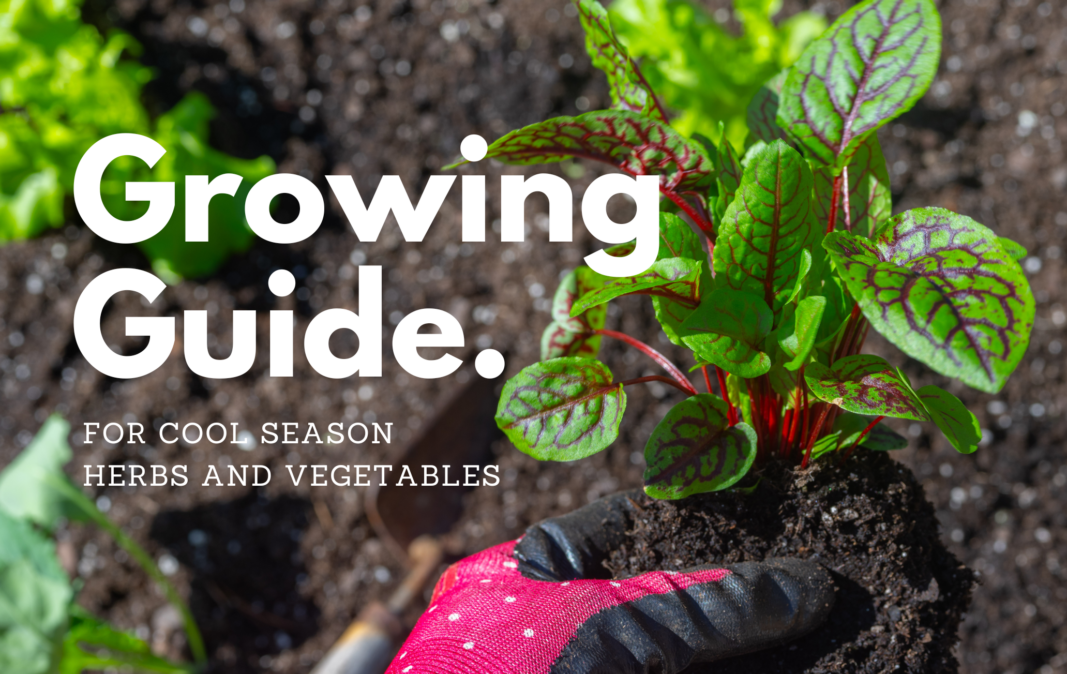 Bryn Wallace
Bryn WallaceCool Season Growing Guide
Early spring is a great time to plant herbs and vegetables that thrive in cooler weather. Herbs like chives, cilantro and parsley grow best from March through early to mid-summer. Vegetables, such as arugula, beets, bok choy, broccoli, Brussels sprouts, cabbage, carrots, cauliflower, chives, cilantro, garlic, kale, kohlrabi, lettuce, onions, peas, radishes, spinach and turnips perform best in temperatures below 70 degrees F and above 20 degrees F, so they’re perfect for spring and early summer harvest.
You can start your cool season crops indoors from seed, direct sow into the ground or plant starter plants (transplants). Follow our cool season growing guide to plant and harvest vegetables easily from spring into early summer.
Growing From Transplants
The easiest way to begin is from a transplant, which is a seedling that has already reached a few inches in height and can be purchased in small grower pots. Choosing transplants over seed is typically more popular since they grow faster than seeds and you can skip the first weeks or months of waiting for germination and sprouting. Transplants can be planted directly into your garden from late February to early April. While any cool season vegetable can be started from either a transplant or a seed, Brussels sprouts, broccoli and other head-forming greens are generally easier to grow from transplants due to the time it takes to grow from seed. We also carry starter root vegetables, such as beets, garlic and onions, which you can learn about in our root vegetable growing guide and our garlic and onions guide.
Growing From Seed
Starting Indoors
Starting cool season vegetables from seed not only makes for a great winter project, it allows for a wide variety of vegetable choices, from our most popular varieties to heirloom and less common cultivars. You can start cool season vegetable seeds very early in the year when it’s too cold for other gardening projects. January or February is a great time to begin. Cool season vegetables and herbs enjoy the cool temperatures and prefer to be planted in the ground in March in our area. We recommend starting your seeds inside, 10 to 12 weeks before the average last frost date. You can find directions for starting your seeds in our seed starting guide.
We recommend hardening off your seedlings when they are 3 to 4” tall, normally about 6 to 8 weeks after seeding. Since they’ve been inside, they are not yet used to the wind, sun and outdoor temperatures. We suggest slowly acclimating them to the outdoor environment by placing them out of direct sunlight and bringing them inside overnight. Continue this process for 4 to 5 days. After about 5 days, your seedlings can be planted in the ground.
Direct Sowing Outdoors
Some cool season vegetables and herbs grow quickly and do not need to start indoors early in the season. These include: arugula, beets, carrots, chives, cilantro, lettuces, parsley, radishes and turnips. Sow these directly into the outdoor soil in March. Arugula, chives, cilantro, lettuces, parsley and radishes generally take about 4 to 6 weeks from their planting to harvest. Beets, carrots and turnips take around 6 to 8 weeks.
Cool Season Planting Process
1. Amend your soil. Most vegetables grow best in soil with a slightly acidic pH rating. A pH test will help determine how much lime is needed to bring your soil to the ideal pH range. Home test kits are easy to use, or soil testing labs can provide more comprehensive results. You can also bring in a quart of your soil to the plant clinic at our Gainesville and Fair Oaks locations and we can test it for pH. See our Plant Clinic specialists for more information. In addition to lime, we recommend giving your plants an extra nutrient boost using Bumper Crop, Coast of Maine Lobster Compost and Leafgro and turning it into the soil before planting.
2. Cover the soil with mulch. Once your soil is amended, we recommend covering the area with a 1” layer of straw or another mulch of your choice to insulate your crops and suppress weed growth. We recommend straw because it is inexpensive, lightweight, suppresses weeds and retains moisture. You can also use other mulches, such as oak bark, pine needles, shredded hardwood and Virginia fines.
3. Create a small trench for your seeds or transplants. Before planting in a row, raised bed, or flower bed, pull back the mulch and pull a trench in the soil 6 to 8” deep. Then, apply some fertilizer, such as Garden Tone or a 5-10-5 blend, to the bottom of the trench. If you’re transplanting, cover the fertilized soil with a light layer of the soil you initially dug up. If you’re planting from seed, backfill the trench with the soil that you dug up. If you’re putting the seeds or transplants into a container, we recommend placing Merrifield Potting Mix into the container and working Garden Tone in to blend it into the soil. Then, either dig holes for the transplants or place your seeds on the top of the soil and cover it based on the instructions on the seed packet.
4. Place your transplants or direct sow your seed. If you’re growing from transplants, place your plants into the trench or container and backfill the soil. Bring the mulch back over the base of your plants. If you’re direct sowing, follow the instructions on your seed packet and place your seeds at the recommended depth and spacing. You will want to keep your mulch away from the seeds until you see strong sprouts emerging from the ground. When your seedlings are established at around 3 to 4” tall, you can pull your mulch back to cover the base of the seedling.
5. Thin your seedlings if you’re direct sowing seeds. As the seedlings grow, thin them out by removing the weakest plants so they have adequate space. The ideal space is about 2 to 3” for arugula, carrots, chives, cilantro, lettuces, parsley and radishes and 3 to 6” for larger plants, such as beets and turnips.
6. Apply supplemental fertilizer during the growing season. Once your seedlings are established, about 4 to 6 weeks into the growing season, fertilize by sprinkling your Garden Tone or 5-10-5 around the surface of the base of your plants.
Harvesting
Once your crops are ready to harvest, head out to your garden and collect your vegetables for delicious late spring and summertime meals with friends and family. Here are some of the most popular cool season vegetables and their time to harvest from seed.
- Plant
- Arugula
- Beets
- Bok Choy
- Broccoli
- Brussels Sprouts
- Cabbage
- Carrots
- Cauliflower
- Chives
- Cilantro
- Garlic
- Kale
- Kohlrabi
- Lettuce
- Onions
- Parsley
- Peas
- Radishes
- Spinach
- Turnips
- Time to Harvest
- 4 to 6 weeks
- 6 to 8 weeks
- 35 to 40 days
- 2 to 3 months
- 3 to 4 months
- 3 to 4 months
- 6 to 8 weeks
- 2 to 3 months
- 4 to 6 weeks
- 4 to 6 weeks
- 4 to 9 months
- 3 to 4 months
- 3 to 4 months
- 4 to 6 weeks
- 3 to 4 months
- 6 to 8 weeks
- 6 to 8 weeks
- 4 to 6 weeks
- 35 to 45 days
- 4 to 6 weeks for greens/8 to 10 weeks for roots
These cool season vegetables will turn to seed and will stop producing flower heads and edible vegetables if they get too warm. This process, called bolting, typically happens in late June to July. We recommend harvesting all outputs before this happens.
Potential Pests
The most typical pest to affect cool season vegetables and herbs is cabbage worm, which shows up on plants in the cabbage family, including broccoli, Brussels sprouts and cauliflower. To keep these critters from chewing on your plants, we suggest applying Spinosad, an organic insecticide that works well to prevent and remove cabbage worms from your vegetables. We also commonly see slugs in our area. To control these pests, we sell an organic slug treatment called Sluggo, which is a natural product approved for use in vegetable gardens.



